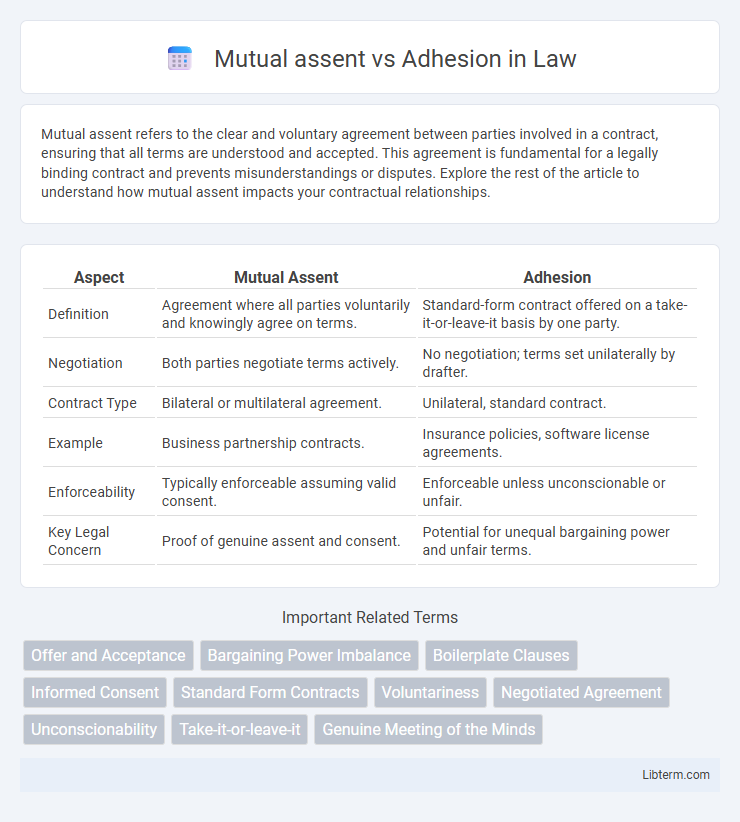Mutual assent refers to the clear and voluntary agreement between parties involved in a contract, ensuring that all terms are understood and accepted. This agreement is fundamental for a legally binding contract and prevents misunderstandings or disputes. Explore the rest of the article to understand how mutual assent impacts your contractual relationships.
Table of Comparison
| Aspect | Mutual Assent | Adhesion |
|---|---|---|
| Definition | Agreement where all parties voluntarily and knowingly agree on terms. | Standard-form contract offered on a take-it-or-leave-it basis by one party. |
| Negotiation | Both parties negotiate terms actively. | No negotiation; terms set unilaterally by drafter. |
| Contract Type | Bilateral or multilateral agreement. | Unilateral, standard contract. |
| Example | Business partnership contracts. | Insurance policies, software license agreements. |
| Enforceability | Typically enforceable assuming valid consent. | Enforceable unless unconscionable or unfair. |
| Key Legal Concern | Proof of genuine assent and consent. | Potential for unequal bargaining power and unfair terms. |
Understanding Mutual Assent: The Meeting of Minds
Mutual assent represents the clear agreement of all parties involved in a contract, embodying a genuine meeting of the minds essential for enforceability. This concept ensures that each party understands and agrees to the terms without coercion, mistake, or misrepresentation. In contrast, adhesion contracts often present a take-it-or-leave-it scenario, where one party holds disproportionate power, potentially undermining true mutual assent.
Defining Adhesion Contracts: Take-It-Or-Leave-It Agreements
Adhesion contracts are pre-drafted agreements presented on a take-it-or-leave-it basis without negotiation, often favoring the stronger party. These contracts lack mutual assent since the adhering party typically cannot alter terms but must accept them as-is or forgo the transaction. The imbalance of bargaining power in adhesion contracts contrasts with mutual assent contracts, where both parties voluntarily agree to terms through negotiation.
Key Legal Elements of Mutual Assent
Mutual assent requires a clear offer and an unequivocal acceptance, demonstrating both parties' intent to be bound by the contract's terms. Essential elements include a meeting of the minds and a mutual understanding of the contractual obligations. Adhesion contracts, by contrast, often involve standardized terms presented by one party, limiting genuine mutual assent due to unequal bargaining power.
Characteristics and Common Uses of Adhesion Contracts
Adhesion contracts are standardized agreements drafted by one party with stronger bargaining power and presented to the other on a "take-it-or-leave-it" basis, lacking meaningful negotiation or mutual assent. These contracts commonly appear in consumer settings such as insurance policies, credit card agreements, and software licenses, where uniform terms streamline transactions but may limit the weaker party's ability to modify terms. Their characteristics include clear, non-negotiable terms favoring the drafting party, often scrutinized for fairness and enforceability in courts due to the imbalance in bargaining power.
Consent in Mutual Assent vs. Adhesion Settings
Consent in mutual assent requires clear, voluntary agreement between parties, reflecting a negotiated understanding and equal bargaining power. In adhesion contracts, consent is often implied through acceptance of standardized terms without negotiation, raising concerns about fairness and the true voluntariness of the agreement. The key distinction lies in the ability to reject or modify terms in mutual assent versus the take-it-or-leave-it nature of adhesion contracts.
Power Dynamics: Bargaining Strength and Inequality
Mutual assent requires equal bargaining strength where both parties freely negotiate terms, reflecting balanced power dynamics. Adhesion contracts, however, often involve significant power inequality, with one party imposing standard terms and limited negotiation opportunity. This disparity undermines genuine consent, highlighting the influence of bargaining power on contractual fairness.
Enforceability: Courts’ Approach to Each Agreement Type
Courts enforce mutual assent agreements by ensuring that both parties clearly agree on essential terms, reflecting genuine consent and balanced negotiation. Adhesion contracts often face stricter scrutiny, with enforceability hinging on the absence of unconscionable terms or unfair surprise to the weaker party. Judicial review emphasizes fairness, often invalidating adhesion agreements that impose oppressive conditions or lack reasonable notice.
Risks and Criticisms of Adhesion Contracts
Adhesion contracts pose significant risks due to their one-sided nature, often leaving consumers with little to no bargaining power, which can lead to unfair terms and potential exploitation. These contracts are frequently criticized for lacking genuine mutual assent, as the non-negotiable terms can undermine the principle of informed consent and create an imbalance favoring the drafting party. Courts may scrutinize adhesion contracts for unconscionability, but the imbalance of power and limited transparency remain persistent issues that challenge contract fairness and enforceability.
Protecting Parties: Legal Safeguards and Remedies
Mutual assent requires clear, voluntary agreement between parties, supported by legal safeguards such as the necessity of offer, acceptance, and consideration to ensure fairness and enforceability. Adhesion contracts, often presented on a "take-it-or-leave-it" basis, trigger judicial scrutiny to protect weaker parties from unfair terms through doctrines like unconscionability and good faith. Courts provide remedies including contract reformation, voiding oppressive clauses, and imposing equitable relief to uphold justice and balance in contract enforcement.
Practical Implications for Businesses and Consumers
Mutual assent requires clear agreement between parties, ensuring both businesses and consumers understand and consent to contract terms, fostering transparency and reducing disputes. Adhesion contracts, often standardized and non-negotiable, can advantage businesses by streamlining transactions but may expose consumers to unfair terms, increasing the risk of litigation or regulatory scrutiny. Businesses must balance efficiency with fairness, while consumers need to carefully review adhesion agreements to protect their rights and avoid unforeseen obligations.
Mutual assent Infographic

 libterm.com
libterm.com